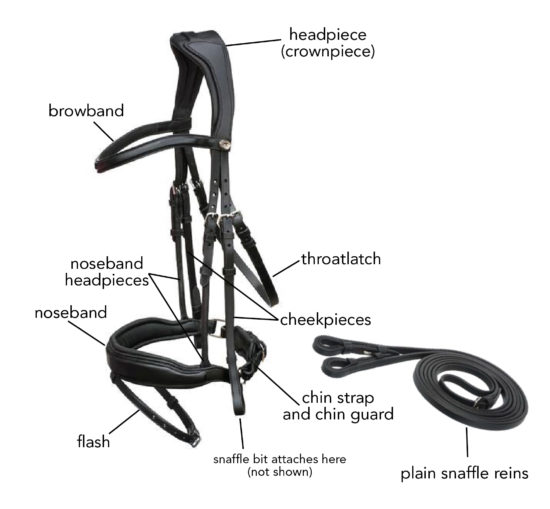It’s all in your head… or your horse’s head! Fitting a Bridle Properly – Part I
 Even though you may know that of course your bridle has to fit your horse properly, you may be surprised to hear of the impact a poorly fitting bridle may have on your horse. This week I will go into some of the key points on the horse’s head, continuing with these in the next blog, and then finish off the series in a third blog with some pros and cons of the various types of bridles available for your consideration. Bridle fit can be considered just as important as saddle fit to maintain your horse’s comfort and optimum performance.
Even though you may know that of course your bridle has to fit your horse properly, you may be surprised to hear of the impact a poorly fitting bridle may have on your horse. This week I will go into some of the key points on the horse’s head, continuing with these in the next blog, and then finish off the series in a third blog with some pros and cons of the various types of bridles available for your consideration. Bridle fit can be considered just as important as saddle fit to maintain your horse’s comfort and optimum performance.
No other part of the anatomy has as many sensitive areas as the head. Recent design changes in bridles to become more ‘anatomically friendly’ are crucial in ensuring your horse is comfortable with his headgear. There are many nerves in the horse’s head. Some of them originate at exactly those areas where the noseband or flash lie.
If a bridle is too tight, all sorts of behavioural issues can arise, including tossing the head, lack of chewing, and lack of engagement with an unwillingness to move. These reactions warrant a closer look to what’s under the skin of the horse’s head. The gross anatomy of the head is easily recognizable in a horse – there is only a thin layer of skin covering the skull, while veins and muscles are only minimally visible. What you don’t see are the multitudes of nerves, and the delicate connective tissue at the various junctions of bone – all of which make the head extremely sensitive to pressure and pain.
This connective tissue between the 29 individual bones of the skull, plus a jaw which allows a side to side movement of the teeth during mastication, are responsible for movement of the head.
There are numerous nerves originating at the base of the skull, spreading upwards over the skull – and often present exactly where the various pieces of the bridle would lie. Too much pressure caused by the bridle can also cause referred pain elsewhere; muscles can cramp up and engagement will disappear. Fascia (connective tissue) runs through the entire body. A poorly fitting bridle can even cause problems all the way down to the hocks – impacting the flexibility and range of motion. Although there are unfortunately only a few studies documented concerning how a poorly fitting bridle impacts a horse, there is anecdotal evidence of this, and horses do move better in a bridle that fits. The most severe problems arise in the neck/base of the skull if the bridle fits badly (where the headpiece lies), but a noseband or flash that is buckled too tightly will also cause problems here.
The Neck
Sensitive bursa are found between the nuchal ligament and the first two cervical vertebrae. Bursa are little sacs filled with fluid with the job of preventing the ligament from rubbing on the vertebrae and getting damaged. They cannot withstand a lot of pressure, and will react to a poorly fitting or too-tightly-buckled bridle by increasing fluid production and swelling. They become obviously swollen – for dressage horses this is seen mainly at the atlas (1st) vertebra, and in jumping horses mainly at the 2nd cervical vertebra.
These affected bursa are not only visually obvious, but may cause the horse to ignore the aids, toss its heads, or refuse to go on the bit. When it really hurts, the horse may ‘invert’ its neck in an attempt to escape the pain. The muscles of the topline may begin to atrophy, and the horse develops a ‘ewe’ neck. Even well-intentioned padding of the headpiece may actually be counter-productive – instead of helping, padding can even increase the pressure and cause skin folds – which may lead to further concentrated pressure points. (Again – it’s trial and error on your own horse to see the reaction to more padding). There is no universal formula for all horses as to ‘how much is too much’ when it comes to the ability to withstand pressure at the headpiece. A sensible rider will listen to her horse and see what works for her (while recognizing that these issues may not necessarily be actually due to poorly fitting bridle, but could also arise from dentition problems or even simple rider error!)
The bridle should be fitted to allow a hand to slip under easily at the headpiece. There should be two fingers room between the cavesson/noseband and the nose. Bridles should be considered as a DIY craft- project – with potentially differently sized noseband, headpiece, and cheekpieces to accommodate the individual horse.
A noseband which is too tight can also impact the horse’s neck and the ability to engage. For full comfort and relaxed movement, a horse’s bridle should still allow the horse to chew freely. Chewing movement means the jaw needs to be able to move side to side freely. If the horse tries to chew with a bridle that is too tight, the resistance will cause cramping of the jaw muscles and pressure in the neck – and this muscle ‘bracing’ will impact the horse’s entire musculature and ability to engage. Some horses are in such pain around their heads that riders may have misdiagnosed them as being ‘head shy’. This can be avoided by properly fitting bridles.
©2017 Saddlefit 4 Life® (with thanks to St. Georg, June 2017 issue)
